Kankiesi-Tos Dual Republic: Difference between revisions
No edit summary |
No edit summary |
||
| (11 intermediate revisions by the same user not shown) | |||
| Line 12: | Line 12: | ||
|alt_coat = | |alt_coat = | ||
|national_motto = ''Vé Lenoxen vielkop nif! Prev nyafet ké pfot Leyonateté?'' | |national_motto = ''Vé Lenoxen vielkop nif! Prev nyafet ké pfot Leyonateté?'' | ||
|national_anthem = ''"Ni | |national_anthem = ''"Ni Savelèy"'' | ||
|image_map = Etsenes_MapMap.png | |image_map = Etsenes_MapMap.png | ||
|alt_map = | |alt_map = | ||
| Line 46: | Line 46: | ||
| area_km2 = 1,759,541 | | area_km2 = 1,759,541 | ||
| area_sq_mi = {{convert|386561|km2|sqmi|0|disp=output number only}} | | area_sq_mi = {{convert|386561|km2|sqmi|0|disp=output number only}} | ||
|percent_water = 11.37% | |||
|population_estimate = {{increase}} 93,260,000 | |population_estimate = {{increase}} 93,260,000 | ||
|population_estimate_year = 1096 AKE | |population_estimate_year = 1096 AKE | ||
| Line 60: | Line 61: | ||
|HDI = 0.883 | |HDI = 0.883 | ||
|HDI_year = 1096 AKE | |HDI_year = 1096 AKE | ||
|HDI_change = (+0.649) | |||
|Gini = 34.45 | |||
|Gini_year = 1096 AKE | |||
|currency = Tsenes Tsik (₮) | |currency = Tsenes Tsik (₮) | ||
|currency_code = TSK | |||
|time_zone = TTZ | |time_zone = TTZ | ||
|utc_offset = -0+ | |utc_offset = -0+ | ||
| Line 68: | Line 73: | ||
|calling_code = +18 | |calling_code = +18 | ||
}} | }} | ||
'''Etsenes''', officially the '''Kankiesi-Tos Dual Republic''' ([[Meskiyon]], ''[[Kankiesi-Tos Dual Republic|Miléyke Kankiesia Tos Olnihʟaʟ]]'' {{wp|Help:IPA|[Mælejkɛ Kænkisi Tɔs ɔneyhʟaʟ]}}) is a republic located in Katzen, situated between the Srzek Mountains in the East, Kios Tiklet (Tiklet Sea) in the west, the Tos highlands and eventually the Kios Nyetenl (Nyetenl Sea) in the north, the Kiosikn Ostrek in the south-west, and the Kiosin Tsikot in the south east with a small bridge into the interior of the continent in the south-central region. | '''Etsenes''', officially the '''Kankiesi-Tos Dual Republic''' ([[Meskiyon]], ''[[Kankiesi-Tos Dual Republic|Miléyke Kankiesia Tos Olnihʟaʟ]]'' {{wp|Help:IPA|[Mælejkɛ Kænkisi Tɔs ɔneyhʟaʟ]}}) is a republic located in Northeastern [[Katzen]], situated between the Srzek Mountains in the East, Kios Tiklet (Tiklet Sea) in the west, the Tos highlands and eventually the Kios Nyetenl (Nyetenl Sea) in the north, the Kiosikn Ostrek in the south-west, and the Kiosin Tsikot in the south east with a small bridge into the interior of the continent in the south-central region. | ||
[[Category:Countries]] | [[Category:Countries]] | ||
| Line 78: | Line 83: | ||
==History== | ==History== | ||
===Prehistory=== | ===Prehistory=== | ||
It is highly unclear where they originated, but the arrival of the Enesez Tribes in 740 BKE (184 AD) marked the beginning of Tsenes Civilization. 23 years later, the tribal people split up, the Kantaket tribe migrating south into the lowlands, which provide fertile and easily colonizable land. The Enesez meanwhile stayed in the highlands and mountains, which provide rich natural defenses but poor soil, natural resources, and trade ability, forcing them to continue in their traditional ways of life, with little technological advancement. as the Kantaket tribes settled the lowlands and southern areas, they lived in peace with the | It is highly unclear where they originated, but the arrival of the Enesez Tribes in 740 BKE (184 AD) marked the beginning of Tsenes Civilization. 23 years later, the tribal people split up, the Kantaket tribe migrating south into the lowlands, which provide fertile and easily colonizable land. The Enesez meanwhile stayed in the highlands and mountains, which provide rich natural defenses but poor soil, natural resources, and trade ability, forcing them to continue in their traditional ways of life, with little technological advancement. as the Kantaket tribes settled the lowlands and southern areas, they lived in peace with the natives for a short time, but due to disputes about territorial encroachment, the more advanced Kantaket tribes expelled the natives from the lands, forcefully moving them onto Pfet Island (the Pfet Peninsula at the time) in the north of the region, which eventually became the nation of [[Beauqouit]]. | ||
As time went on, the Enesez tribe had more breakups which saw two more waves of settlers moved south to assimilate with the Kantaket, who mostly accepted them into their developing society. Meanwhile the Enesez tribe discovered the northern coast of Etsenes and slowly migrated from the highlands onto that coast, leaving the highlands depopulated and mostly barren. This also left many very well preserved abandon Enesez settlements for later discovery. The issue with this migration is that this added only another level of isolation to the Enesez settlements, who as a result didn't urbanize their land very much compared to the Kantaket tribes. | As time went on, the Enesez tribe had more breakups which saw two more waves of settlers moved south to assimilate with the Kantaket, who mostly accepted them into their developing society. Meanwhile the Enesez tribe discovered the northern coast of Etsenes and slowly migrated from the highlands onto that coast, leaving the highlands depopulated and mostly barren. This also left many very well preserved abandon Enesez settlements for later discovery. The issue with this migration is that this added only another level of isolation to the Enesez settlements, who as a result didn't urbanize their land very much compared to the Kantaket tribes. | ||
| Line 98: | Line 103: | ||
Liyven I easily crushed the remaining resistance for his cousin, Eleméy II. After that, he consolidated his power and, using the loyal soldiers of the Kankasian Military, invaded the territories that were annexed by the Etsosn States. They then went further and invaded the rest of Etsosn. Annexing much of the Tos territory and entirely reforming the borders of the area, creating 3 distinct Tos states rather than keeping the lot of them, which consisted of more than 55 independent Duchies and Kingdoms. He then turned his sights south to the southeastern plain, which had been a thorn in the side of Kankaska for centuries. | Liyven I easily crushed the remaining resistance for his cousin, Eleméy II. After that, he consolidated his power and, using the loyal soldiers of the Kankasian Military, invaded the territories that were annexed by the Etsosn States. They then went further and invaded the rest of Etsosn. Annexing much of the Tos territory and entirely reforming the borders of the area, creating 3 distinct Tos states rather than keeping the lot of them, which consisted of more than 55 independent Duchies and Kingdoms. He then turned his sights south to the southeastern plain, which had been a thorn in the side of Kankaska for centuries. | ||
===The 2nd Kankiesian Empire=== | |||
{{Infobox country | |||
|image_map = 2nd kankiesk.png | |||
|map_caption = The height of the second Kankiesian Empire overlaid with modern borders. | |||
}} | |||
===Unification of [[Kankiesk|Kankiesk]] and [[Tosn]]=== | ===Unification of [[Kankiesk|Kankiesk]] and [[Tosn]]=== | ||
===Etsenes and Communism=== | ====Tos concerns about Unification==== | ||
Etsenes unified in 1036 AKE after [[The War for Proshznef]]. Though this was not certain to happen due to Tos concerns about loosing the power to govern themselves. The two united under a Dual Constitutional Monarchy, which enshrined both nation's royal families in a special status. Not long afterwards, only 6 days to be exact, the people revolted against the Monarchy, toppling it and placing Kankiesian Syndicalist, [[Elvok Helostanaf]], into office. | |||
====Etsenes and Communism==== | |||
====Economic Policy==== | =====Economic Policy===== | ||
Syndical President [[Elvok Helostanaf]] instituted programs such as Universal Basic Income, which is based on the idea that each month people who are considered adults are given a certain amount of money per month, which in this case was 3000 Tsiks per month. This policy proved to be a mistake as the economy practically collapsed. Unemployment soared to an average of 22% of the working age population, at the height of this, the numbers went as high as 33%. Meanwhile, the government, began printing more Tsiks, unaware of the fact that the more money that is introduced into society, the less it is valuable. This economic policy lasted year and caused incredible damage to the economy, something that is still felt in the modern day in the form of an extremely low value currency. | |||
====Foreign Policy==== | =====Foreign Policy===== | ||
[[Elvok Helostanaf]]'s foreign policy differed from many states that were and are considered "Communist". He did not act in a hostile nature towards Capitalist Nations. Instead, He was fairly friendly to them, or not aggressive rather. He noted the importance of said nations to the survival of Etsenes. One famous interaction between nations was [[the war between Etsenes and Fluver]], which raged through the decade. Towards the end of his regime though, Helostanaf did make peace with the Fluverans. | [[Elvok Helostanaf]]'s foreign policy differed from many states that were and are considered "Communist". He did not act in a hostile nature towards Capitalist Nations. Instead, He was fairly friendly to them, or not aggressive rather. He noted the importance of said nations to the survival of Etsenes. One famous interaction between nations was [[the war between Etsenes and Fluver]], which raged through the decade. Towards the end of his regime though, Helostanaf did make peace with the Fluverans. | ||
====The Collapse==== | =====The Collapse===== | ||
Shortly after making peace with Fluver, Etsenes unfortunately was in a bad place economically. The main selling point of Helostanaf's economic policies proved to be dangerous and ineffective. Things such as Universal Basic Income and the private to public shift of many of the nation's factories did nothing but place the economy in ruins. The Tsik collapsed in value down to a fraction of its original value and not many strides had been made domestically or internationally. 11 years after the beginning of Helostanaf's Regime, on August | Shortly after making peace with Fluver, Etsenes unfortunately was in a bad place economically. The main selling point of [[Elvok Helostanaf|Helostanaf]]'s economic policies proved to be dangerous and ineffective. Things such as Universal Basic Income and the private to public shift of many of the nation's factories did nothing but place the economy in ruins. The Tsik collapsed in value down to a fraction of its original value and not many strides had been made domestically or internationally. 11 years after the beginning of [[Elvok Helostanaf|Helostanaf]]'s Regime, on August 28th, 1047, he was stripped and toppled from power in a chaotic, and nearly violent revolution and was later jailed for crimes committed against the people of the nation. Including killing off political opponents and forced labor by criminals in terrible environments. The people gathered together in opposition for Helostanaf's brutal regime and fought bravely. The Military also assisted the civilians and preformed a coup d'tat in the nation. Establishing a temporary Military Junta in the nation for just 2 weeks until a constitution was drafted by the leaders of the revolution. | ||
=== | ===Post Communism Etsenes=== | ||
Placed economic turmoil from [[Elvok Helostanaf|Helostanaf's]] Syndicalist Economic Policies, the economy suffered. A recession in the nation began just days after the collapse of Communism, which caused the nation to sink into a severe economic depression. Many poor people literally died from starvation as food became scarce because nobody could afford it. Slowly though, the Tsik regained a small amount of value, stabilizing with a small amount of purchasing power per Tsik. But the effects of Syndicalism lasted decades on the brittle nation. | |||
==Geography== | ==Geography== | ||
| Line 124: | Line 138: | ||
===Climate=== | ===Climate=== | ||
The climate within Etsenes is temperate, if not a tad warm and humid. The warm current coming in from the West of the nation splits in south Etsenes giving it a comfortable climate. The North of the nation, due to its geographic positioning and the warm current, gets a very rainy, temperate rainforest climate. The rain there lasts all the time causing occasional mudslides and floods. | |||
{{Infobox country | |||
|image_map = Curennty.png | |||
|map_caption = Tsenes Ocean Currents. | |||
}} | |||
===Environment=== | ===Environment=== | ||
| Line 142: | Line 160: | ||
==Foreign Relations== | ==Foreign Relations== | ||
===The Velohnt Duchy=== | |||
WIP {{Infobox country | |||
|image_map = Pompeiiiii.png | |||
|map_caption = A Family tree of succession of the Kankiesian Crown. | |||
}} | |||
==Economy== | ==Economy== | ||
===Technology=== | ===Technology=== | ||
===Energy=== | ===Energy=== | ||
| Line 158: | Line 177: | ||
==Demographics== | ==Demographics== | ||
WIP {{Infobox country | |||
|image_map = PopulationPyramid.png | |||
|map_caption = Population Pyramid of Etsenes. | |||
}} | |||
===Education=== | ===Education=== | ||
| Line 170: | Line 192: | ||
====Sports==== | ====Sports==== | ||
====Stereotypes==== | |||
Latest revision as of 14:04, 27 October 2020
This article is incomplete because it is pending further input from participants, or it is a work-in-progress by one author. Please comment on this article's talk page to share your input, comments and questions. Note: To contribute to this article, you may need to seek help from the author(s) of this page. |
The Dual Kankiesi-Tos Republics Miléyke Kankiesia Tos Olnihʟaʟ | |
|---|---|
| Motto: Vé Lenoxen vielkop nif! Prev nyafet ké pfot Leyonateté? | |
| Anthem: "Ni Savelèy" | |
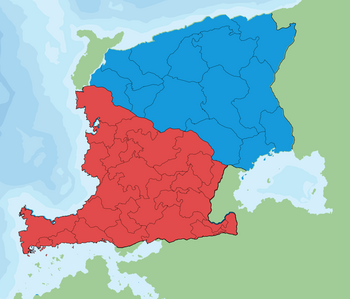 A map of Etsenes, the red highlighted area is Kankiesk, while the blue is Tosn. | |
| Capital | Miséy Îll Néy Hʟaʟ |
| Largest city | Hovrfaliéyn |
| Official languages | Meskiyon |
| Recognized national languages | Veztokr, Alat |
| Recognized regional languages | Eneskezt, Fetkinyn, Kvaz, Oktap, Tevkot |
| Ethnic groups (1096 AKE) | Kankiesian, Tos |
| Demonym(s) | Tsenes, Kankiesian, Tos |
| Government | Dual Federal Republic |
• Leyont of Tosn | Nika Meyrel |
• Leyont of Kankiesk | Eriey Vernoff |
| Legislature | The Vekoz |
| History | |
• The Arrival of Enesez Tribes in the highlands | 740 BKE (184 AD) |
• The Kantaket tribes break away and settle south in the lowlands | 717 BKE (207 AD) |
• Unification of Kankiesk and Tosn | 1032 AKE (1955 AD) |
| Area | |
• Total | 1,759,541 km2 (679,363 sq mi) |
• Water (%) | 11.37% |
| Population | |
• 1096 AKE estimate | |
• 1093 AKE census | |
• Density | 53.0/km2 (137.3/sq mi) |
| GDP (PPP) | estimate |
• Total | ₮397,167.552 ($49,645.944) |
| GDP (nominal) | 1096 AKE estimate |
• Total | ₮37.04 Trillion ($4.63 trillion) |
| Gini (1096 AKE) | 34.45 medium |
| HDI (1096 AKE) | 0.883 very high |
| Currency | Tsenes Tsik (₮) (TSK) |
| Time zone | UTC-0+ (TTZ) |
| Date format | dd/mm/yyyy AKE |
| Driving side | left |
| Calling code | +18 |
| Internet TLD | .KT |
Etsenes, officially the Kankiesi-Tos Dual Republic (Meskiyon, Miléyke Kankiesia Tos Olnihʟaʟ [Mælejkɛ Kænkisi Tɔs ɔneyhʟaʟ]) is a republic located in Northeastern Katzen, situated between the Srzek Mountains in the East, Kios Tiklet (Tiklet Sea) in the west, the Tos highlands and eventually the Kios Nyetenl (Nyetenl Sea) in the north, the Kiosikn Ostrek in the south-west, and the Kiosin Tsikot in the south east with a small bridge into the interior of the continent in the south-central region.
Etymology
The name Etsenes (Ets/E/ns) has very unclear origins, but it is generally just the name of the area in which the modern day Kankiesi-Tos Dual Republics inhabits, which is why the nation is generally just called Etsenes rather than its ridiculously long official name.
In Meskiyon, Etsenes (Ets/E/ns) is actually pronounced "Itsenez" (E/ts/eh/neh/z), but much like in English, the demonyms for the two prominent sub-ethnic groups in the nation are the Kankiesians and the Tos, which are apart of the greater Tsenes (Meskiyon: Tsenz, Ts/eh/nz) ethnicity
History
Prehistory
It is highly unclear where they originated, but the arrival of the Enesez Tribes in 740 BKE (184 AD) marked the beginning of Tsenes Civilization. 23 years later, the tribal people split up, the Kantaket tribe migrating south into the lowlands, which provide fertile and easily colonizable land. The Enesez meanwhile stayed in the highlands and mountains, which provide rich natural defenses but poor soil, natural resources, and trade ability, forcing them to continue in their traditional ways of life, with little technological advancement. as the Kantaket tribes settled the lowlands and southern areas, they lived in peace with the natives for a short time, but due to disputes about territorial encroachment, the more advanced Kantaket tribes expelled the natives from the lands, forcefully moving them onto Pfet Island (the Pfet Peninsula at the time) in the north of the region, which eventually became the nation of Beauqouit.
As time went on, the Enesez tribe had more breakups which saw two more waves of settlers moved south to assimilate with the Kantaket, who mostly accepted them into their developing society. Meanwhile the Enesez tribe discovered the northern coast of Etsenes and slowly migrated from the highlands onto that coast, leaving the highlands depopulated and mostly barren. This also left many very well preserved abandon Enesez settlements for later discovery. The issue with this migration is that this added only another level of isolation to the Enesez settlements, who as a result didn't urbanize their land very much compared to the Kantaket tribes.
The Kantaket began trade with other cultures around the year 703 BKE and became a recognizable group of people as a result, as the isolated Enesez kept to themselves much more and slowly built their own society on principles of isolation and harmony within their civilization.
Etsosn and Kenkaska
The tribes eventually developed into the much more civilized nations of Etsosn and the Kenkaska Kingdoms.
Kankiesi-Tos Dual Republic | |
|---|---|
 A map of the middle ages borders, as well as trade routes and cities. |
Who despite being from the same lineage and being in close quarters with one another, always saw one another as rivals, bringing about centuries of war and conquest. Under King Yeskevot of the Hikov Dynasty, Kenkaska blocked trade from flowing into Etsosn from its borders in an attempt to weaken them, and this succeeded in hindering trade and the transportation of new ideas into Etsosn, while Kenkaska flourished and formed many large cities on the coast, which eventually became large ports for trading. Feudalism was installed within both nations which both had very large peasant populations. The Royals had large, luxurious castles and cathedrals built for residing and worship, while the peasants had separate, smaller churches in which they would worship their beliefs, whatever they where. This was around the year 519 AD (405 BKR)
The Dark Ages of Kankaska
King Laemis II died around the year 844 AD (81 BKE) sparking a civil war of succession within Kankaska between Laemis III, his brother Eleméy I, and their cousin, Ménilas. This civil war brought about a dark age in which thousands died fighting for who they believed should be King or Queen. Eventually, Eleméy I won the war, but at the cost of thousands of lives and an even more unstable nation. Eleméy I ruled a ruined nation that was littered with constant rebellion and economic chaos. His son, Eleméy II, did even worse, who launched a war with neighboring Etsosn States, who promptly united against Kankaska to defend themselves, a move that everyone saw coming except Eleméy II. The war brought chaos in Northeastern Kankaska and caused even more rebellion. Eventually, A plague struck at the most inopportune time, flaring up all across Kankaska. This pushed the populace to their limit. Eleméy II was overthrown by his cousin, Liyven I, who eventually ended up being the father of the 1st Kankiesian Empire.
The 1st Kankas Empire
Liyven I easily crushed the remaining resistance for his cousin, Eleméy II. After that, he consolidated his power and, using the loyal soldiers of the Kankasian Military, invaded the territories that were annexed by the Etsosn States. They then went further and invaded the rest of Etsosn. Annexing much of the Tos territory and entirely reforming the borders of the area, creating 3 distinct Tos states rather than keeping the lot of them, which consisted of more than 55 independent Duchies and Kingdoms. He then turned his sights south to the southeastern plain, which had been a thorn in the side of Kankaska for centuries.
The 2nd Kankiesian Empire
Kankiesi-Tos Dual Republic | |
|---|---|
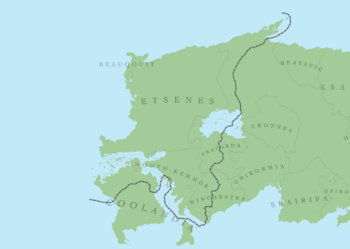 The height of the second Kankiesian Empire overlaid with modern borders. |
Unification of Kankiesk and Tosn
Tos concerns about Unification
Etsenes unified in 1036 AKE after The War for Proshznef. Though this was not certain to happen due to Tos concerns about loosing the power to govern themselves. The two united under a Dual Constitutional Monarchy, which enshrined both nation's royal families in a special status. Not long afterwards, only 6 days to be exact, the people revolted against the Monarchy, toppling it and placing Kankiesian Syndicalist, Elvok Helostanaf, into office.
Etsenes and Communism
Economic Policy
Syndical President Elvok Helostanaf instituted programs such as Universal Basic Income, which is based on the idea that each month people who are considered adults are given a certain amount of money per month, which in this case was 3000 Tsiks per month. This policy proved to be a mistake as the economy practically collapsed. Unemployment soared to an average of 22% of the working age population, at the height of this, the numbers went as high as 33%. Meanwhile, the government, began printing more Tsiks, unaware of the fact that the more money that is introduced into society, the less it is valuable. This economic policy lasted year and caused incredible damage to the economy, something that is still felt in the modern day in the form of an extremely low value currency.
Foreign Policy
Elvok Helostanaf's foreign policy differed from many states that were and are considered "Communist". He did not act in a hostile nature towards Capitalist Nations. Instead, He was fairly friendly to them, or not aggressive rather. He noted the importance of said nations to the survival of Etsenes. One famous interaction between nations was the war between Etsenes and Fluver, which raged through the decade. Towards the end of his regime though, Helostanaf did make peace with the Fluverans.
The Collapse
Shortly after making peace with Fluver, Etsenes unfortunately was in a bad place economically. The main selling point of Helostanaf's economic policies proved to be dangerous and ineffective. Things such as Universal Basic Income and the private to public shift of many of the nation's factories did nothing but place the economy in ruins. The Tsik collapsed in value down to a fraction of its original value and not many strides had been made domestically or internationally. 11 years after the beginning of Helostanaf's Regime, on August 28th, 1047, he was stripped and toppled from power in a chaotic, and nearly violent revolution and was later jailed for crimes committed against the people of the nation. Including killing off political opponents and forced labor by criminals in terrible environments. The people gathered together in opposition for Helostanaf's brutal regime and fought bravely. The Military also assisted the civilians and preformed a coup d'tat in the nation. Establishing a temporary Military Junta in the nation for just 2 weeks until a constitution was drafted by the leaders of the revolution.
Post Communism Etsenes
Placed economic turmoil from Helostanaf's Syndicalist Economic Policies, the economy suffered. A recession in the nation began just days after the collapse of Communism, which caused the nation to sink into a severe economic depression. Many poor people literally died from starvation as food became scarce because nobody could afford it. Slowly though, the Tsik regained a small amount of value, stabilizing with a small amount of purchasing power per Tsik. But the effects of Syndicalism lasted decades on the brittle nation.
Geography
Kankiesi-Tos Dual Republic | |
|---|---|
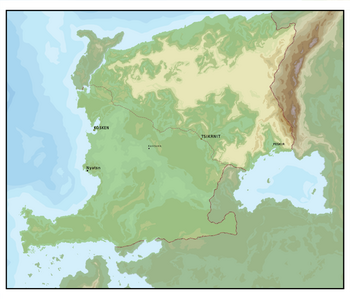 Topographical Map of Etsenes with Major Cities |
Etsenes has a total area of 1,759,541 km2, (679,363 sq mi), which is a fairly large size considering the size of the continent in all. Etsenes has actually be blessed with near perfect geography, the Srzek mountains in the North-East largely protect the nation from outside invaders, and the North, West, Central-East and South are all flanked by coast, The only geographic weakness the nation is presented with is the South-Eastern plain, which funnels foreigners right up into the nations heartland: the Lowlands. As a result, the nation has sought protection for its South-Eastern border for most of its history. Due to the fact that there are no natural barriers near the nations South-Eastern borders, the nation's primary focus for centuries is to A. Build a military that is powerful enough to keep out any invader, and B. Put as much distance between this weakness and foreign empires as possible. As a result, the Kankiesians have built some of the largest empires in the history of the continent.
Climate
The climate within Etsenes is temperate, if not a tad warm and humid. The warm current coming in from the West of the nation splits in south Etsenes giving it a comfortable climate. The North of the nation, due to its geographic positioning and the warm current, gets a very rainy, temperate rainforest climate. The rain there lasts all the time causing occasional mudslides and floods.
Kankiesi-Tos Dual Republic | |
|---|---|
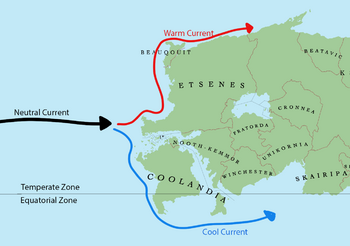 Tsenes Ocean Currents. |
Environment
wip
Politics and Government
wip
Military
Army
Airforce
Foreign Relations
The Velohnt Duchy
WIP
Kankiesi-Tos Dual Republic | |
|---|---|
 A Family tree of succession of the Kankiesian Crown. |
Economy
Technology
Energy
Industry
Infrastructure
Transport
Demographics
WIP
Kankiesi-Tos Dual Republic | |
|---|---|
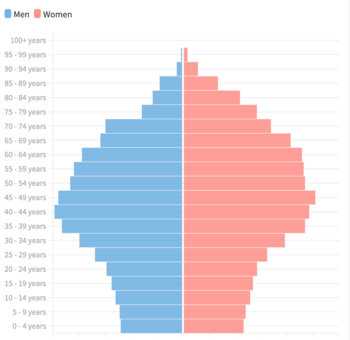 Population Pyramid of Etsenes. |

